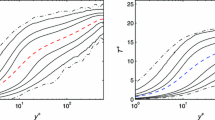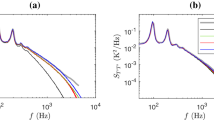Abstract
In using the empirical expression of King's law,E 2=E 20 + BU″, to correlate the data obtained from constant temperature hot wire in real low turbulence flow, the value of exponentn can assume widely differing values and is never a universal constant. Also corrections must be employed for varying ambient fluid temperature from the temperature at which calibration was carried out.
This paper discuss the possibility of replacing King's law by another empirical expression,E 2=E 20 + BU 0.5 + CU, in which the exponentn will be fixed at a value 0.5 and the termCU is regarded as a correction factor for changing the exponentn in King's law as well as for the effect of ambient temperature drift.
The advantages of using the new expression, beside incorporating the required corrections, are reflected on reducing the errors in local sensitivity resulted from using approximated exponent in King's law, and its validity for very low mean velocities.
Zusammenfassung
Benützt man den empirischen Ausdruck des Kingschen Gesetzes,E 2=E 20 + BU n, um die Meßwerte eines Konstanttemperatur-Hitzdrahtes bei sehr niedriger Turbulenz zu korrelieren, so kann der Wert des Exponentenn sehr unterschiedliche Werte annehmen und ist nie eine universelle Konstante. Es müssen auch Korrekturen angebracht werden, wenn die Fluid temperatur von der Temperatur abweicht, bei der der Hitzdraht geeicht wurde.
Dieser Aufsatz diskutiert die Möglichkeit, das Kingsche Gesetz durch eine andere empirische Formel,E 2=E 20 +BU 0.5 +CU, zu ersetzen, in der der Exponentn zu 0,5 festgelegt wird und in der der AusdruckCU als Korrekturfaktor für den sich ändernden Exponentenn in dem Kingschen Gesetz und auch für den Einfluß abweichender Umgebungstemperatur betrachtet wird.
Die Vorteile dieser neuen Formulierung mit den vorgeschlagenen Änderungen liegen in der Reduzierung von Fehlanalysen bei örtlich besserer Empfindlichkeit und in der Gültigkeit des Ansatzes auch für sehr niedrige Geschwindigkeiten.
Similar content being viewed by others
Abbreviations
- B :
-
slope of the best fit line which relatedE 2 andU 0.5
- C :
-
correction factor in equation (3)
- C l :
-
correction factor for temperature drift
- C E :
-
correction factor for same output voltage
- C s :
-
correction factor for same sensitivity
- Δ C :
-
error in correction factor
- E :
-
output voltage of hot wire, volt
- E a :
-
output voltage atT a , volt
- E c :
-
output voltage atT c , volt
- E 0 :
-
extrapolated value whereU=zero, volt
- \(\sqrt {\bar e^2 } \) :
-
r.m.s. for voltage fluctuations, volt
- n :
-
exponent in King's law
- Δ n :
-
error in exponentn
- Re :
-
Reynold's number
- S :
-
local sensitivity=dE/dU
- T a :
-
fluid temperature,°C
- T c :
-
fluid temperature during calibration,°C
- T w :
-
hot wire temperature,°C
- ΔT T a -T c ,° CU :
-
mean velocity, m/s
- \(\sqrt {\bar u^2 } \) :
-
r.m.s. for velocity fluctuation, m/s
- τ:
-
\(\frac{{T_w - T_a }}{{T_w - T_c }}\)
References
Perry, A. E.: Hot wire anemometer. Oxford: Clarendon Press 1982
Hinze, J. O.: Turbulence. New York: McGraw-Hill 1959
Collis, D. C.; Williams, M. J.: Two dimensional convection from heated wire at low Reynold's number. J. Fluid Mech. 6, 3 (1959) 357–384
Bradshaw, P.: An introduction to turbulence and its measurement. Oxford: Pergamon Press 1975
Aydin, M.; Leutheusser, H.: Very low velocity calibration and application of hot wire probes. DISA Information No. 25 (Feb. 1980)17–18
Elsner, J.; Gundlach, R.: Some remarks on the thermal equilibrium equation of hot wire probes. DISA Information No. 14 (March 1973) 21–24
Bearman, P.: Corrections for the effect of ambient temperature drift on hot wire measurements in incompressible flow. DISA Information No. 11 (May 1971) 25–30
Kanevce, G.; Oka, S.: Correcting hot-wire readings for influence of fluid temperature variations. DISA Information No. 15 (Oct. 1973) 21–24
Siddall, R.; Davies, T.: An improved response equation for hot-wire anemometry. J. Heat Mass Transfer 15 (1972) 367–368
Author information
Authors and Affiliations
Rights and permissions
About this article
Cite this article
Shibl, A. Empirical expression for hot wire with corrections for temperature drift. Wärme- und Stoffübertragung 21, 329–332 (1987). https://doi.org/10.1007/BF01376287
Received:
Issue Date:
DOI: https://doi.org/10.1007/BF01376287




